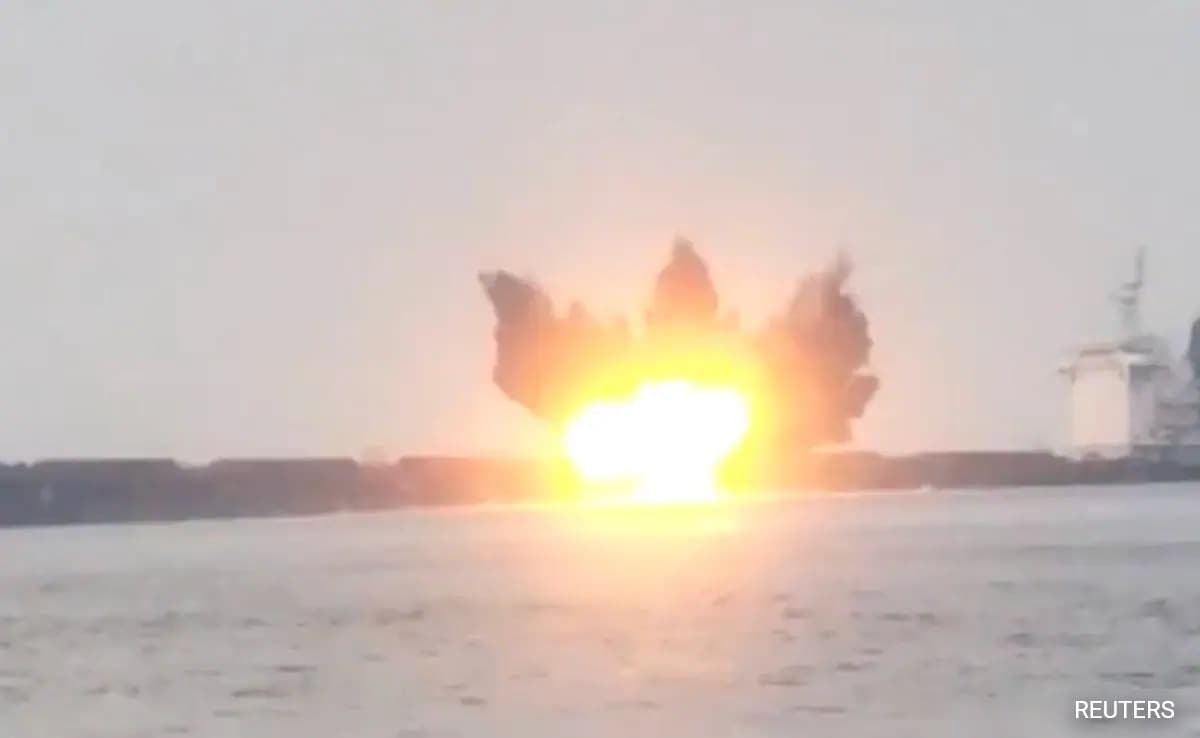This photo taken on March 8, 2019, shows a study underway on the seafloor of the Clarion-Clipperton Zone to investigate the impact that potential manganese nodule mining in the deep sea would have on ecosystems there.
| Photo Credit: ROV-Team/GEOMAR
An unknown process is producing oxygen deep in the world’s oceans, where it is too dark for photosynthesis, scientists reported on July 22 in the journal Nature Geoscience. The finding has important implications because oxygen helps support life and the discovery implies the existence of previously unknown ecosystems.
Many governments are also bound to take notice since one explanation for the oxygen is that polymetallic nodules are transporting electric charges that split water molecules around them, releasing oxygen. Polymetallic nodules are lumps of iron, manganese hydroxides, and rock partially submerged in many parts of the ocean floor. If their concentration exceeds 10 kg per sq. m, mining them is considered to be economically feasible — and many countries are planning to do so as a new resource.
On July 22, Reuters reported an unnamed “top government scientist” saying India is planning to “apply for licences to explore for deep-sea minerals in the Pacific Ocean”. India’s Ministry of Earth Sciences is also currently building a submersible vehicle that will look for and mine similar resources in the Indian Ocean as part of its ‘Deep Ocean Mission’.

Where was the study conducted?
The oxygen discovery raises questions about how deep-sea mining to extract polymetallic nodules will affect marine ecosystems.
The scientists behind the study, from Germany, the U.K., and the U.S., were studying the Clarion-Clipperton Zone, a part of the ocean floor off Mexico’s west coast. Covering an area larger than India, the Zone is considered to have the world’s highest concentration of polymetallic nodules, including 6 billion tonnes of manganese and more than 200 million tonnes each of copper and nickel.
When the scientists were conducting experiments at a depth of 4 km, they noticed the oxygen concentration in some places rapidly increased instead of decreasing. They conducted follow-up studies in 2020 and 2021. In each case, they released a device from the surface that would land on the ocean floor, where it would isolate a small volume of the floor along with some sea water and measure the oxygen levels.
This underwater region is called the abyssal zone. It receives too little sunlight for photosynthesis to be feasible. Instead, life-forms here get oxygen from water carried in by a global circulation called the ‘Great Conveyor Belt’. Still, the amount of oxygen is low and without any local production, the device should have measured the oxygen levels dropping as small animals consumed it. But the scientists found the opposite: it increased, sometimes tripling in just two days.
They double-checked the finding by recreating the conditions on the ocean floor in their lab, and found the oxygen levels to increase up to a point before dropping.
What is the source of the oxygen?
When they measured the physical characteristics of the nodules, they found their surfaces to have a voltage of up to 0.95 V. Splitting one water molecule requires 1.5 V, but the researchers have suspected the voltage could build up if many nodules are close together, like the cells of a battery.
Andrew Sweetman, an ecologist with the Scottish Association for Marine Science in the U.K. and a coauthor of the study, told Nature, “We have another source of oxygen on the planet, other than photosynthesis.” His team is calling it ‘dark oxygen’.
Oxygen sources are valuable because they allow life to survive. But as the lab experiment indicated, the nodules could only produce oxygen as long as they could muster a sufficient voltage. The nodules’ own energy source is also not clear.
What is deep-sea mining?
Given the quantity of metals polymetallic nodules on the ocean floor hold, deep-sea mining is expected to be a major marine resource extraction activity in the coming decades. The International Seabed Authority has established 15-year contracts with at least 22 contractors — including the Government of India — to look for polymetallic nodules, polymetallic sulphides, and cobalt-rich ferromanganese crusts in the deep seabed. China alone is expected to mine 17% of the Clarion-Clipperton Zone.
The new finding raises the possibility of such mining damaging ecosystems that require ‘dark oxygen’ to survive. Experts have found deep-sea mining itself could be harmful to the marine environment, ‘dark oxygen’ or not.

In 1989-1996, scientists from Germany conducted the Disturbance and Recolonisation (DISCOL) Experiment in the Peru Basin as the world’s “first large-scale impact assessment” to assess the “environmental impacts originating from the mining of polymetallic nodules”. They built a device that disturbed the sea floor like a deep-sea mining exercise might have and collected data about how the disturbances changed local oceanographic and sedimentological profiles, among other things.
A 2019 study in the journal Scientific Reports reported that “the effects of simulated mining impacts induced during the DISCOL [Experiment] were still evident in the megabenthos of the Peru Basin after 26 years.”
How will deep-sea mining be affected?
The same study also reported “significantly lower heterogeneity diversity in disturbed areas” and added that “if the results of this experiment … can be extrapolated to the Clarion-Clipperton Zone, the impacts of polymetallic nodule mining there may be greater than expected, and could potentially lead to an irreversible loss of some ecosystem functions”.
In November 2023, Nature reported based on a paper published then that deep-sea mining “for minerals could harm deep-sea jellyfish, according to the first study of mining impacts on animals living in the water column.”
Scientists also know less about ecosystems in the abyssal zone than they do about many of those aboveground, which means the models scientists use to predict their fate and their role in global climate processes could be unreliable. With these and other issues in mind, on July 20, three major European insurance companies said they would exclude deep-sea mining from their underwriting portfolios.
‘Dark oxygen’ adds to these challenges. If deep-sea mining doesn’t find sustainable ways to respond to them, it may be rendered altogether infeasible.












